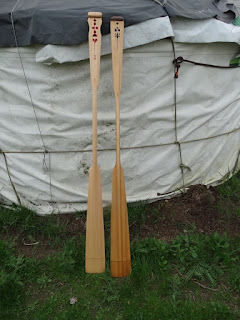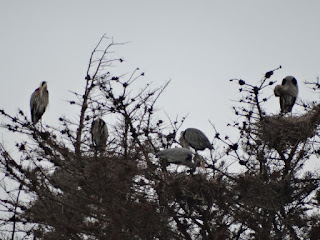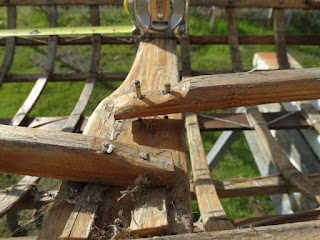Yesterday I got in a full day on the playboat. Let's backtrack. The lashings on the playboat were rotting from too much sun. So I decided to strip the skin off the boat and redo the lashings. Soon as the skin was off the boat, ideas arose. Let's stretch the boat two feet by adding an Unangan style nose and tail to it, thereby increasing volume (with me in it the stern was frequently under water) and improving its tracking, making it more suitable to SF Bay paddling than its original configuration. So part 2 is mostly about adding the nose and tail to the original boat and replacing two deck beams. Still haven't tackled the relashing.
1
 |
| To get the right shape for the nose piece, I clamped two slats to the gunwales then laid a piece of plywood over the top and traced lines inside the slat to transfer the shape to the piece of plywood. |
2
 |
| Here are the lines for the new nose piece. |
3
 |
| The new nose piece installed. I also rounded the bottom edge of the nose piece. |
4
 |
| A view of the nose piece from the bottom. |
5
 |
| I added two pieces of new wood right behind the nose piece to fair the top into the gunwales. |
6
 |
| Here's the ragged deck beam that needed replacing. |
7
 |
| And here's its replacement. |
8
 |
| The backrest also needed replacing. Here it is detached from the gunwales. The original problem was that someone had sat down on it too hard and cracked the dowels that attached it to the gunwales. |
9
 |
| The new backrest in place. The wider shoulders give it more contact with the gunwales and hopefully make it harder to break off from the gunwales. I also used three screws on each end instead of the dowels I used previously. |
10
 |
| The new nose piece in place. |
11
 |
| The new tail piece in place along with a new keelson. |
12
 |
| And finally, a long shot of the whole thing. |
End notes: Still to go, relashing and painting of the frame and sewing on a new skin and painting that.
Not mentioned so far, the trick with redoing the boat was to make the new shape such that the boat would trim properly with the skin on. Since the boat sat a little low in the back for my weight, I figured that the extra volume in the stern would rectify that, provided that I didn't add too much extra volume in the bow. We won't know till I put the new skin on and float this boat.
As for materials used in the overhaul, the new nose and tail pieces are redwood for rot resistance. Moisture seems to linger longer in the two ends of the boat. The backrest replacement was made of white ash that I salvaged off a discarded bed frame. White ash is strong though not necessarily very rot resistant, but since was right at the cockpit, it should have a chance to dry out better than the wood in the ends of the boat. In any case, the boat should be good for another ten years.













































